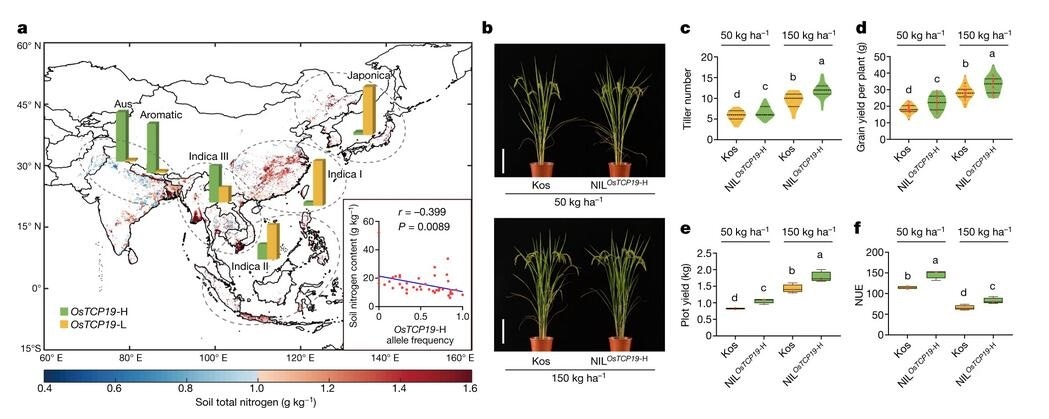Chinese researchers from the Institute of Genetics and Developmental Biology of the Chinese Academy of Sciences (CAS) have identified a gene that plays a significant role in helping rice adjust to low nitrogen levels in soil.

OsTCP19 has great potential in improving rice NUE. a, OsTCP19-H is significant correlated with soil nitrogen content. b-f, OsTCP19-H significantly increases grain yield and NUE under LN and MN conditions. Image Credit: IGDB.
Application of nitrogen fertilizers is a strategic challenge for sustainable agriculture: While this Application plays a crucial role in boosting crop yields, thus guaranteeing global food security, it also poses a major threat to ecosystems.
Due to this reason, breeding new varieties of crops with high nitrogen use efficiency (NUE) is a major priority for both environmental protection and agricultural development.
The team used a diversified rice population obtained from different ecogeographical areas and carefully assessed how numerous agronomic traits reacted to nitrogen in fields with varying conditions of nitrogen supply.
The researchers subsequently conducted a genome-wide association study (GWAS) and to their amazement, identified just one highly significant GWAS signal. They also characterized the detailed mechanisms of how OsTCP19 plays a role in the regulation of rice tillering.
More fascinatingly, the team analyzed global soil nitrogen content data and identified a strong link between the global soil nitrogen-content distribution and allelic variation of OsTCP19.
The high NUE allele—OsTCP19-H—is highly preserved in rice types grown in nitrogen-poor areas but has been lost in rice types grown in nitrogen-rich areas.
Most importantly, OsTCP19-H is also abundant in wild rice—the ancestor of contemporary cultivated rice—which was grown in natural soil without using any artificial fertilizer input. Since contemporary rice cultivars are primarily grown with abundant nitrogen supply, OsTCP19-H has, therefore, largely been lost.
Hence, breeding high-yield crops with reduced nitrogen input can be achieved by bringing OsTCP19-H back to contemporary cultivars.
Undoubtedly, introgression of OsTCP19-H into contemporary cultivars can enhance the efficiency of nitrogen use by 20% to 30% under conditions of reduced nitrogen supply. Due to this reason, contemporary cultivated rice can be considerably enhanced by bringing the lost allele back through the use of poor-soil landraces that mostly preserve the valuable genes of wild rice.
This is truly groundbreaking. It will have implications not only for the basic understanding of how plants/rice works, but also has enormous implications for reducing fertilizer use.”
Dale Sanders, Professor and Director of the John Innes Centre, Chinese Academy of Sciences Headquarters
The discoveries represent a significant innovation in high NUE breeding and plant nutrition research, and they will significantly benefit sustainable agriculture.
The study provides new insights about the genetic foundation for the geographic adaption of cultivated rice to soil fertility and also gives a clue about efficiently dissecting other complex traits.
Source:
Journal reference:
Liu, Y., et al. (2021) Genomic basis of geographical adaptation to soil nitrogen in rice. Nature. doi.org/10.1038/s41586-020-03091-w.